The trumpeter swan is a large waterfowl species native to North America. They are known for their distinctive call, which sounds like a trumpet, hence the common name. Their large size makes them the largest extant species of waterfowl on the continent.
The trumpeter swan population was once near extinction in 1933, with only 69 individuals remaining. Fortunately, aerial surveys discovered a Pacific population of trumpeter swans along Alaska’s Copper River.
However, the population has bounced back thanks to conservation efforts by various wildlife agencies and the Trumpeter Swan Society. It now has a healthy breeding population in Alaska and other parts of the northern United States and southern Canada.
Trumpeter Swan Description
Adult Trumpeter Swans
The trumpeter swan is known for its pure white plumage, similar to the tundra swan, which gives it a striking appearance. However, some individuals may have a pale gray or brown tinge to their feathers.
The adult trumpeter swan has a bulbous white head with a long black bill. Its eyes, legs and webbed feet are black, contrasting nicely with its white feathers. Its neck is straighter than the neck of a mute swan (Cygnus olor).
Adult male trumpeter swans, known as cobs, are slightly larger than adult females, known as pens. They also have a slightly longer and more curved bill. Females tend to have a more slender and delicate appearance compared to males.
Trumpeter swans are larger than mute swans, which have an orange bill.
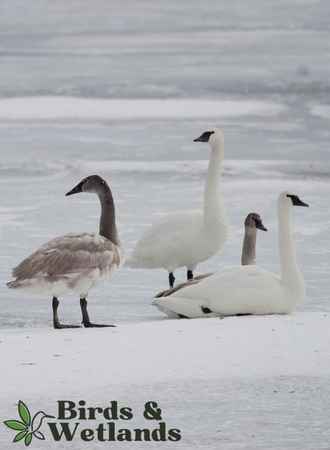
Young Trumpeter Swans
Juvenile trumpeter swans, known as cygnets, have a grayish-brown plumage that is much different from the pure white of adult birds. They also have a shorter, straight bill and their legs and feet are gray. This plumage remains until the spring migration.
Listen to the Trumpeter Swan
Trumpeter Swan Habitat
The preferred nesting and breeding habitats of trumpeter swans include large, shallow wetlands with a mix of open water and emergent vegetation, such as marshes, bogs, and wet meadows. These areas provide the trumpeter swans with access to food and protection from predators.
During the breeding season, some of these swans may also use muskrat and beaver dens and small islands as nesting sites.
Before most migration begins, these swans gather in staging areas before migrating south. These areas are typically large, shallow wetlands, such as marshes, bogs, and wet meadows.
The preferred wintering habitats of the these swans are similar to their nesting and breeding habitats, including large, shallow wetlands with a mix of submerged and emergent vegetation, such as marshes, bogs, and wet meadows.
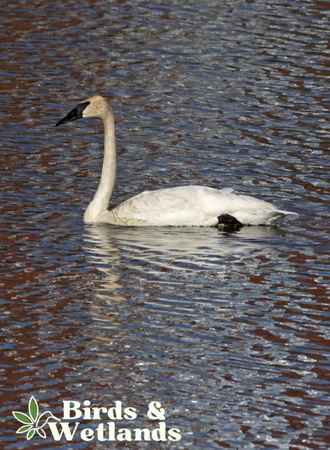
Trumpeter Swan Range & Distribution
Trumpeter swans, the largest native waterfowl species in North America, breeding primarily in Alaska and Canada, with some populations also found in the northern continental North America.
Their breeding range includes areas such as the Yukon-Kuskokwim Delta, the Copper River Delta, the Noatak and Colville River drainages in Alaska, the Mackenzie River Valley, and the Peace-Athabasca Delta in Canada.
During the winter, many young and adult swans migrate south to the United States, with significant populations wintering in states such as Montana, North Dakota, and Minnesota. In South Dakota, wintering birds can be found in LaCreek National Wildlife Refuge.
Wintering trumpeter swans can also be found in other states with suitable habitats, such as Wisconsin, Iowa, and Washington. These wintering areas provide the trumpeter swans access to open water and foraging opportunities. Several thousand trumpeters even reach Arkansas and spend winters along the shores of Magness Lake.
In Canada, trumpeter swans also spend their winters in various habitats, including coastal bays, marshes, and river deltas. Provinces such as British Columbia, Alberta, and Saskatchewan are known to have significant wintering populations.
In Oregon, a non-migratory population of trumpeter swans has been introduced in recent years. This population, which did not previously exist in the state, has been established through a reintroduction program using captive-bred swans.
The swans have been released into suitable habitats, such as the Lower Klamath and Bear Valley National Wildlife Refuges, and have successfully established breeding territories and populations.
Most southern populations of trumpeter swans are year-round residents in their breeding habitat and non-migratory.
Trumpeter Swan Diet
Trumpeter swans are large, white waterfowl that primarily feed on plant material, eating both the leaves and stems of aquatic plants like pondweed, sedges, rushes, arrowleaf, wild celery, bulrush, bur-reed and other aquatic vegetation.
Trumpeter swans also eat grasses and waste crops during the winter months and late fall. While they are mostly herbivorous, they may consume insects and other small invertebrates during their early weeks after hatching.
Trumpeter swans obtain most of their food by grazing near shallow water locations and in agricultural fields where food is abundant, allowing them to stay in one area for an extended period. They eat at least twice a day and can consume up to five pounds of vegetation daily, which is significant considering their weight of 19-30 pounds.
Trumpeter swans may also wander into fields near rivers or lakes to find additional food sources, even on private land.
To reach submerged food, these birds up-end and dabble.
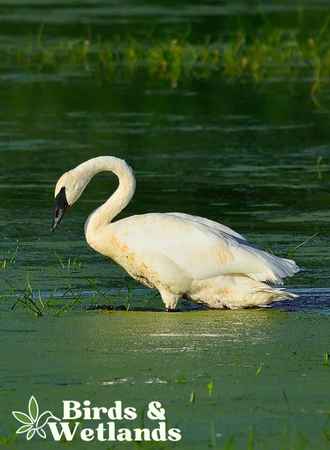
Trumpeter Swan Behavior
Trumpeter swans are known for their strong pair bonds. They are monogamous, meaning they mate for life with one partner. These pair bonds are formed during the nesting season, and the swans will stay together for the rest of their lives.
The bond between the male and female swans is very strong, and they are often seen preening and staying close to each other.
During the mating season, trumpeter swans engage in various courtship displays. The male swan will perform a variety of displays to attract a mate, including head pumping, wing flapping, and vocalizations.
The female swan will also perform displays, such as head nodding and wing flapping. The male swan will also present the female swan with a nest location and help her build the nest.
The most impressive courtship display of the trumpeter swan is the “unison call,” which is when the male and female swan will call out to each other in perfect harmony. This display is believed to strengthen the bond between the pair and signal to other swans that the couple is already paired up.
Trumpeter swans communicate with each other within the flock using a variety of vocalizations and body language. They use honking, grunting, and whistling sounds to communicate.
Trumpeter swans also use body language such as head bobbing, wing flapping, and nodding to communicate with each other.
Hybridization between the trumpeter swan and its close relative, the whooper swan (Cygnus cygnus), has been observed in the wild. This results from interbreeding between the two species, and the resulting hybrid birds are commonly referred to as “whumpers.”
Both swans are even considered the same species by some authorities. Trumpeters are considered the American counterpart of the whooper swans.
It is important to note that hybridization can have negative effects on the genetic diversity of the trumpeter swan population.
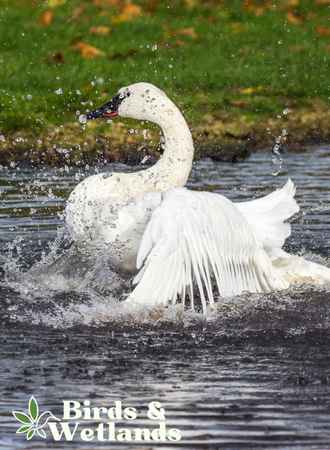
Trumpeter Swan Nesting Habits
Trumpeter swans are known for their distinctive call and beautiful white plumage. These birds are also known for their unique breeding and nesting habits.
Trumpeter swans typically form breeding pairs in late winter or early spring. The breeding season for these birds takes place between April and June. During this time, trumpeter swans can exhibit aggressive territorial behavior, defending their nesting territory and mate from other birds and potential predators.
Trumpeter swans build their nests in various locations, including marshes, wetlands, and along the shorelines of lakes and large rivers. They may also build nests near areas with plenty of floating vegetation.
The nest, which is low mound, is made of vegetation such as mosses, grasses, and twigs and can be quite large, measuring up to 6 feet in diameter and 2 feet in height.
Female trumpeter swans typically lay between four to eight eggs per clutch, with an incubation period of approximately 32-35 days. Both the male and female take turns incubating the eggs until they hatch.
After hatching, the cygnets (baby swans) leave the nest within 24 to 48 hours and onto feeding sites. They can fly and become fully fledged at around 10-12 weeks of age. Once fully fledged, they start to forage for food independently.
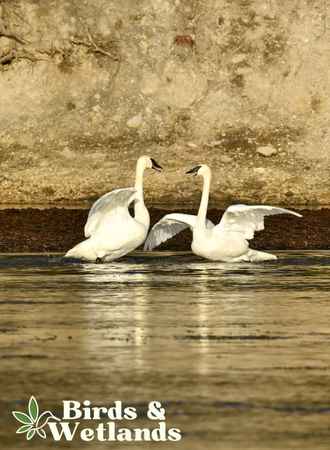
Trumpeter Swan Conservation Status
The Trumpeter Swan is currently classified as a species of Least Concern by the International Union for Conservation of Nature (IUCN). This means that the species is not currently facing an immediate threat of extinction. However, climate change is a clear and ever-present danger to these birds.
In the late 19th and early 20th centuries, the trumpeter swan was nearly hunted to extinction for its feathers used in the millinery trade. Swan skins were also used by females as powder puffs.
Additionally, the destruction of wetland habitats and pollution also contributed to the decline of the North American wild population. By the early 1900s, the population had dropped to fewer than 100 birds.
Conservation efforts have helped the trumpeter swan population to bounce back. In the 1930s, the U.S. government began to protect the species and its habitat through the Migratory Bird Treaty Act.
Additionally, reintroduction programs, such as the one led by the Trumpeter Swan Society and U.S. Fish and Wildlife Service, have helped to rebuild the population.
Habitat restoration and protection continue to be an important part of the conservation efforts to ensure the species’ long-term survival.
Key Takeaways
- Trumpeter swans are immense waterfowl with long necks. They are among the heaviest flying birds in the world and the heaviest living bird native to North America.
- Adult trumpeter swans have mostly white feathers while young swans have gray feathers.
- Trumpeter swans feed almost entirely aquatic plants but they supplement their diet with insects, small invertebrates and fish eggs.
- Trumpeter swans nearly became extinct and disappeared rapidly due to human disturbance, habitat loss, excessive hunting and lead poisoning.


